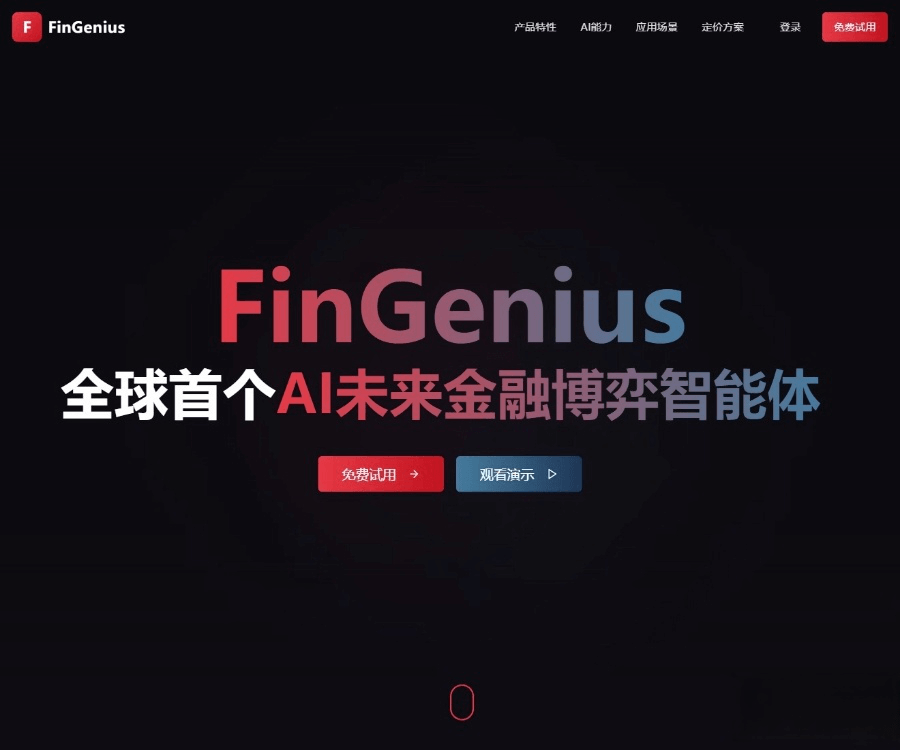In the A-share market, “information overload, delayed decision-making, and difficult risk control” have always been the core pain points of investors and financial institutions – individual investors have no way to start in the face of massive financial report data and public opinion information, institutional analysts need to spend days integrating market dynamics to output reports, and traditional financial instruments are difficult to simulate complex market game behavior. The emergence of FinGenius, the world’s first A-share AI financial game agent, takes “multi-agent game architecture + real-time data processing + personalized decision support” as the core breakthrough, and forms an “AI analysis team” of 16 professional agents (public opinion, floating capital, risk control, etc.), which compresses the financial analysis that originally took several days to the minute level by simulating the interaction of market participants and game theory, and provides “accuracy” for A-share investment decision-making , efficient and safe”.
1. Core subversion: from “single analysis” to “game simulation”, redefining A-share financial analysis
(1) Multi-Agent game system: 16 “super analysts” work together
(2) Real-time data processing and risk warning: Millisecond-level response to lock risks in advance
(3) Growth ring memory rule algorithm: “Exclusive AI advisor” for personalized decision-making
- For conservative investors, the analysis report gives priority to highlighting value indicators such as “company cash flow stability” and “dividend rate”, and the risk warning threshold is lower;
- For short-term traders, the report focuses on “floating capital flows” and “technical support pressure levels”, and provides “intraday trading signals” suggestions;
- For institutional users, the system will automatically generate “sector rotation analysis” and “portfolio risk exposure assessment” based on their investment portfolios (such as “heavy consumption + technology sector”) to help optimize asset allocation. This personalization capability makes FinGenius an “AI advisor that understands the user” rather than a cold analysis tool.
2. Functional matrix: covering the whole process of “analysis-decision-risk” to create an “all-round tool” for A-share investment
FinGenius has designed a series of practical functions around the full cycle of A-share investment, allowing financial analysis to extend from “data integration” to “decision-making”, taking into account professionalism and ease of use.
(1) In-depth data integration and multimodal reporting: from “data stacking” to “insight refinement”
- Breadth of data integration: covering the financial report data of all A-share listed companies, the dragon and tiger list in the past 5 years, real-time public opinion (processing more than 1 billion pieces of information per day), macroeconomic indicators (GDP, CPI, etc.), and industry policy documents to ensure that there are no information dead ends in analysis;
- Report presentation forms: support text reports, visual charts (such as “stock price trend forecast line charts” and “risk point heat maps”), and voice interpretation, individual investors can quickly understand the core conclusions through voice, and institutional analysts can export detailed text reports for internal reporting;
- Key information annotation: The report will be marked with “core positive” (green), “potential risk” (red), and “signal to be verified” (yellow) in different colors, for example, in a new energy stock report, “cost pressure caused by rising upstream lithium prices” is marked in red, and “overseas orders exceed expectations” in green to help users quickly grasp the key points.
(2) Dual-environment architecture: a closed loop from “research and analysis” to “decision-making debate”
- Research environment: 16 agents complete data integration and preliminary analysis here, and output conclusions in their respective fields, such as the public opinion agent proposes that “public opinion is favorable”, and the speculative agent believes that “short-term funds will flow out”;
- Battle environment: Based on the results of the research environment, a “structured debate” is launched between agents – the risk control agent proposes that “policy regulation may inhibit short-term capital flows” in response to the conclusion of the floating capital agent, while the strategic agent combines the views of both sides to optimize the decision-making model through cumulative debate (integrating all historical discussions) to finally form a more comprehensive analysis result. This dual-environment model avoids the “black box of the analysis process” and allows users to trace the generation logic of conclusions and enhance decision-making confidence.
(3) MCP intelligent calling: plug-and-play financial instrument ecosystem
- Call the quantitative trading platform: Convert FinGenius’ analysis results into trading signals and automatically execute “buy/sell” operations;
- Access to the company’s internal database: Institutional users can connect their own financial report analysis systems and customer risk assessment models to make FinGenius’ analysis more suitable for internal business needs.
- Integrated visualization tools: Export analysis data to formats that are recognizable by Tableau and Power BI for easy secondary processing and reporting. This “plug and play” feature allows FinGenius to become a “financial instrument hub” instead of replacing existing tools, improving overall analysis efficiency.
3. Technical support: dual guarantee of real-time and security
(1) Millisecond-level data processing: Keep up with the rhythm of the A-share market
(2) Continuous state management: ensure the coherence and accuracy of decision-making
- Historical data memory: Record the user’s past analysis preferences, focus targets, and risk thresholds, for example, if the user has focused on the “new energy track”, the system will prioritize pushing the latest analysis in this field;
- Analysis process traceability: save the generation logic of each report, including “which agents were called, key data sources, and model parameter settings”, and users can check back at any time to avoid “no basis” for decision-making;
- Dynamic Result Update: When there is a new change in the market (such as sudden policies or company announcements), the system will automatically update the analysis results of relevant agents and adjust the final conclusion simultaneously.
4. Usage process: Four steps to get started, from registration to obtaining analysis reports only 10 minutes
- Registration and Environment Selection: Visit the FinGenius official website (http://fingenius.cn/) or download the app from the Honor, Xiaomi, and Vivo app marketplaces, and register and log in with your mobile phone number or corporate email. Individual users enter “Simplified Mode” by default, and institutional users can switch to “Professional Mode” to unlock more advanced features (such as viewing the multi-agent debate process and customizing agent parameters).
- Input analysis requirements: Enter the target target (such as “Kweichow Moutai” or “New Energy Industry”) or analyze the demand (such as “2025 Q2 Consumer Sector Investment Strategy”) in the search box, and the system will automatically identify the demand type and call the corresponding agent.
- Customized settings (optional): Individual users can adjust risk tolerance (conservative/balanced/aggressive) and investment horizon (short/medium/long-term) in “Preferences”, and institutional users can add API keys through the profile to connect to their own databases or tools;
- View reports and risk monitoring: The system generates analysis reports within 3-5 minutes, and users can view the three modules of “Core Conclusion, Data Support, and Risk Warning”, and click “In-depth Analysis” to view the collaboration process of each agent. If risk warning is enabled, the system will monitor market changes in real time and push reminders through the APP when abnormalities occur.
5. Application scenarios: From personal investment to institutional services, covering all types of financial needs of A-shares
(1) Individual investors: say goodbye to “blindly following the trend” and accurately seize opportunities
(2) Financial institutions: reduce costs and increase efficiency, and improve research and risk control capabilities
- Brokerage Research Institute: Use FinGenius to quickly generate industry weekly reports and individual stock reviews, allowing analysts to focus on “deep logic mining” rather than data integration, increasing research efficiency by 3 times;
- Fund company: Through real-time monitoring of position portfolio risk, when a heavy stock shows a signal of “negative surge in public opinion + net outflow of funds”, the risk control agent immediately warns to help fund managers adjust their positions in a timely manner;
- Private equity institutions: Use multi-agent game models to simulate market behavior and optimize quantitative trading strategies, such as adjusting the entry timing of algorithms based on the capital flow data of floating agents to increase trading returns.
(3) Quantitative trading: Provide accurate signals to capture short-term opportunities in A-shares
FinGenius’ real-time data processing and multi-agent analysis capabilities provide quantitative traders with “timely and accurate” trading signals. The system can output quantitative indicators such as “short-term fluctuation range of individual stocks, inflection points of capital flow, and public opinion heat thresholds”, and traders can automate the whole process of “signal triggering, automatic trading, and risk control” after connecting these indicators to the quantitative model. A quantitative team developed the “Dragon and Tiger List Strategy” based on FinGenius’ floating capital data signals, achieving an excess return of 15% in the A-share volatile market in 2025.
(4) Risk management: identify risks in advance to ensure asset security
6. Summary: The “AI game expert” of A-share financial decision-making opens a new era of intelligent investment
Relevant Navigation

CRIC Deep Intelligent Connection

Gaoding AI Community

Aipy

MuleRun

Txyz

Elements of AI

MachineLearningMastery

